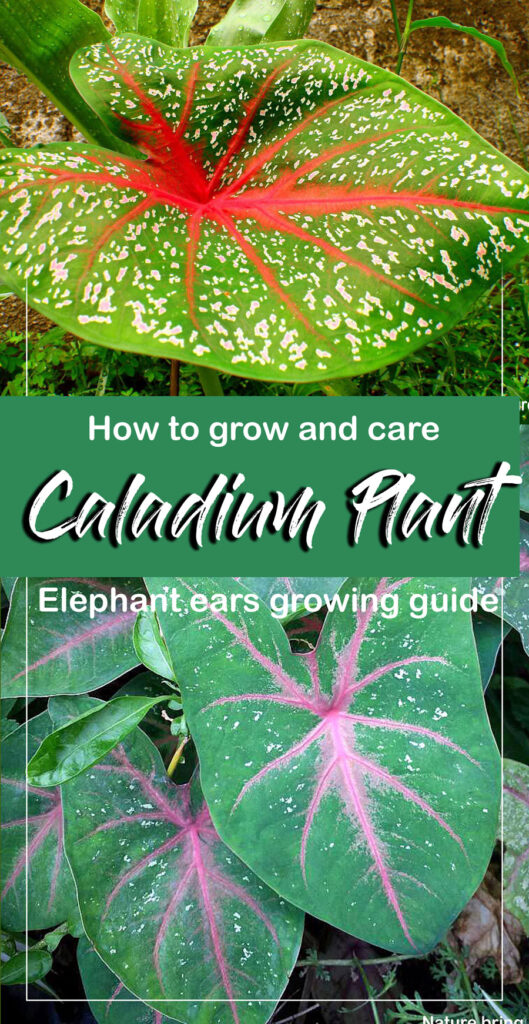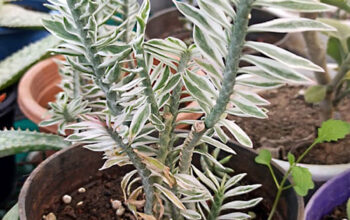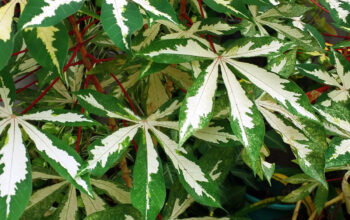Caladium (Elephant ear plant)
The genus Caladium belongs to the family Araceae. They are commonly known as elephant ear plant, hearts of Jesus, and angel wings. In total, over 1000 cultivars of Caladium bicolor have been named from the original South American plant. Seven species of Caladium are native to South America and Central America, and they have naturalized in parts of Africa, India, and a variety of tropical islands. Forests and river banks are their natural habitats, as they grow in open spaces during the dry season and go dormant in the wet season. Most of the leaves on the wild plants are 6-18 inches long and broad and grow to a height of 15–35 inches.

Overview Caladium
Scientific name Caladium
Common name Angel Wings, Caladium, Elephant’s Ears, caladium bicolor.
Plant type Houseplant
Sun Bright, indirect light
Soil Rich, well-draining soil
Soil pH 5.5 – 6.2
Zone 9-11
How to Grow and Care Caladium Plant

It is a heat-loving tropical perennial with amazing foliage, making it a great houseplant. Optimistic colors and patterns adorn the paper-thin leaves, shaped like an arrow or heart. It is an explosion of mottled, veined, striped whites, greens, reds, and pinks. Despite being grown mainly for their foliage, they also produce flowers in the form of spikes, which appear in the form of spathes. It is best to plant these tubers after the threat of frost has passed.
Growing from seeds
Light is essential for the germination of caladium seeds. These plants thrive either outdoors or indoors as houseplants. No matter what type of bulb you choose, it may take two to twelve weeks for the bulbs to germinate. To grow faster, the warmer the temperature at which you plant them and the ground will be, the more quickly they will grow.
Growing from cuttings
It’s possible to save the tubers and replant them next year from the tubers that die back in the fall or early winter. Leaves should die back in the fall. Dry the soil a bit before lifting the tubers. Ensure the box is cool, dry, and dark, like a basement, with temperatures around 55 degrees Fahrenheit. When cutting the tubers in late winter and early spring, use a sharp, sterile cutting tool. A growing site must exist on each new tuber section. Let the tubers “heal” for a week by developing a callus on the cut ends. Once the next growing season begins and soil temperatures reach over 70 degrees Fahrenheit, replant the tubers with the “eye” facing up outside or in pots.
Sunlight
It is best to grow caladiums in a shaded or part-shaded area or bright dappled light. Leaf width determines how much sun the leaves can handle. Caladiums generally tolerate one to two hours of direct sunlight per day, although some sun-loving varieties can tolerate three hours of direct sunlight.

Soil
A moist mixture of soil and peat makes an excellent potting mix for caladiums in the garden or for use in pots. Rich, well-draining soil makes an ideal garden environment. If you add compost or topsoil to your soil when planting, you can improve its texture and fertility. A soil pH of between 5.5 and 6.2 is ideal.
Watering
During periods of dry weather, caladiums need frequent watering. It is recommended that they be watered every week. When growing caladiums in containers, they should be checked and watered as needed. As soon as the leaves begin to turn yellow, stop watering them. Water them again in spring after the winter dormancy period.
Temperature and Humidity
Even though caladiums can tolerate temperatures below 70 degrees F, they won’t grow as well or as large in these conditions. Although they can tolerate temperatures as low as 45 F, this species thrives when the temperature during the day is at least 70 F and the temperature at night is at least 60 F.
If you want to grow indoors, it does well with warmth, bright but indirect light, and plenty of moisture. Keep the humidity as high as is practical. Ideally, the air should be moist (approximately 50% relative humidity). For best results, use a cool-mist humidifier.
Fertilizer
A caladium’s tubers are very sensitive to potash and phosphorus and need plenty of moisture and fertilizer throughout the summer to grow well. During the growing season, use 1 tablespoon of 5-10-10 fertilizer per square foot every 4 to 6 weeks.
Read also: 10 types of indoor cactus plants. How to grow and care Verbena plants. How to grow grapefruit tree. clerodendrum plant (bleeding heart vine) Growing guide. Growing and care silver satin plant (Photos). Cornflower (bachelor button) growing and care tips. Episcia Plant (Flame Violet) growing guide. Bromeliad plants growing and care guide.
For pin:





